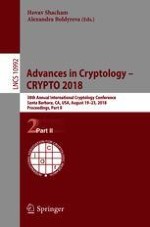2018 | OriginalPaper | Chapter
Constrained PRFs for \(\mathrm{NC}^1\) in Traditional Groups
Authors : Nuttapong Attrapadung, Takahiro Matsuda, Ryo Nishimaki, Shota Yamada, Takashi Yamakawa
Published in: Advances in Cryptology – CRYPTO 2018
Publisher: Springer International Publishing
Activate our intelligent search to find suitable subject content or patents.
Select sections of text to find matching patents with Artificial Intelligence. powered by
Select sections of text to find additional relevant content using AI-assisted search. powered by
Abstract
-
We propose a selectively single-key secure CPRF for circuits with depth \(O(\log n)\) (that is, NC\(^1\) circuits) in traditional groups where n is the input size. It is secure under the L-decisional Diffie-Hellman inversion (L-DDHI) assumption in the group of quadratic residues \(\mathbb {QR}_q\) and the decisional Diffie-Hellman (DDH) assumption in a traditional group of order q in the standard model.
-
We propose a selectively single-key private bit-fixing CPRF in traditional groups. It is secure under the DDH assumption in any prime-order cyclic group in the standard model.
-
We propose adaptively single-key secure CPRF for NC\(^1\) and private bit-fixing CPRF in the random oracle model.


